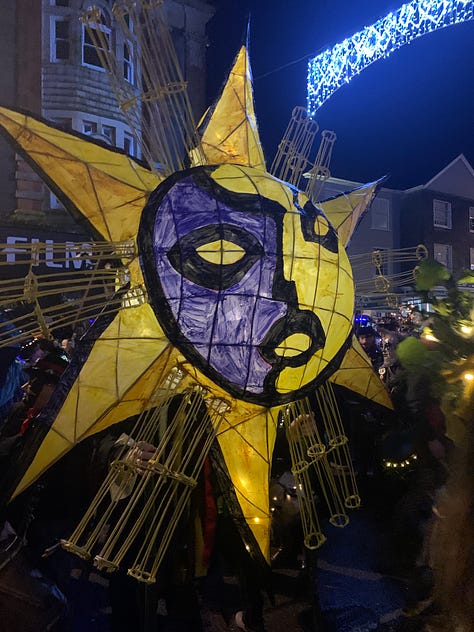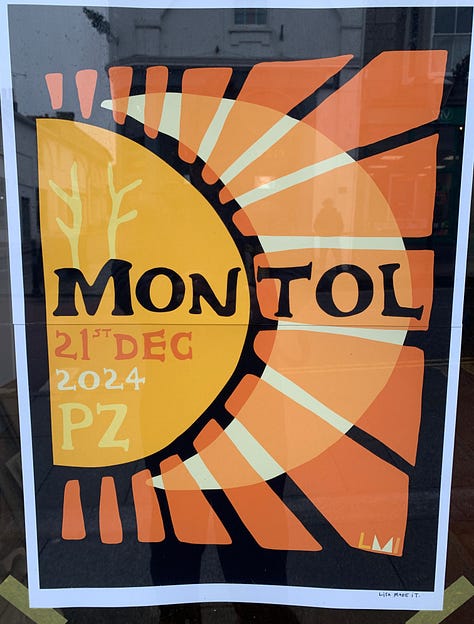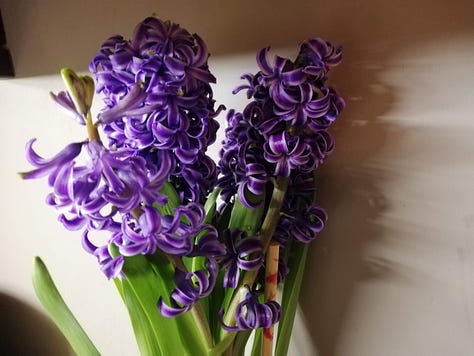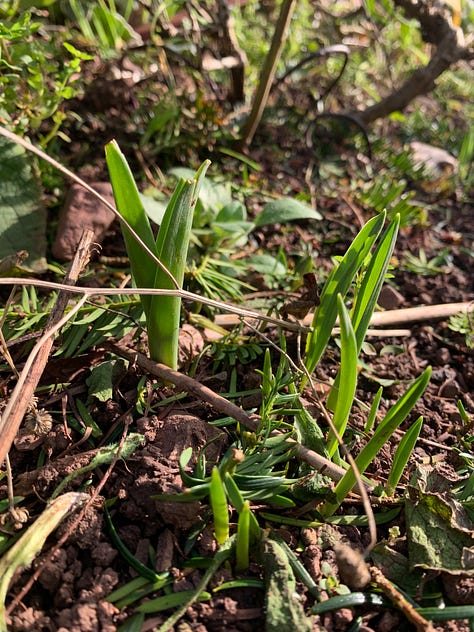Hello hello, how are you doing? As 2025 sets off into the mist I’m hunkering into my animal self and going with the seasons, being where I am. In this time of hyper-connectedness and harry I’m going back to basics and finding meaning and hope in the earth and its ancient patterns.



Midwinter Solstice
On midwinter’s eve, as the northern hemisphere tipped furthest away from the sun and the days were shortest, I was in Penzance, the most westerly town in Cornwall. I was there with my family for Montol, a celebration of the midwinter solstice when time stands still and darkness turns to face the light.
Montol, a Cornish word translated variously as solstice and also balance (from the Latin, Trutina - a set of scales) is Penzance’s annual arts festival, a revival, reimagining and creation of new folk traditions from the Penwith promontory. In the celtic tradition solstices are referred to as the ‘thin place’ - the delicate divide between the spiritual and corporeal; a time of transition and change, of renewal and transformation. At Montol, for a night the world is turned upside down. Revellers try on new personas, delighting in disguise and mischief, mocking the rich and shaking a stick at death and the dark. It is a riot of saturnalia and pagan tradition. An effigy of the sun is paraded through the streets and burned on common ground to whoops and hollers. A Cornish yule log, or Mock, is carried in a pram to the seafront and burned as osses, guisers and a rowdy crowd of revellers link arms and dance to looping Cornish folk melodies.
As I process, part of a tide of wyrd creatures, of feathers, scales, antlers and masks, I feel as if I am both held and falling, knowing and uncertain. A current passes through me, a connection to something deep and old, to the past, present and future, to a time when our survival was bound more tangibly to the return of the sun. I dance, knowing that I am connected to everyone in this midwinter liminality, this opening to beginnings and endings, to constancies and love; that we are meeting in the middle place, walking the line between dark and light.
Imbolc
Perhaps we need to be reminded that darkness is as much a part of life and new beginnings as the light. Imbolc is the pagan start of the year, the mid way point between midwinter and the spring equinox. I’ve decided to adopt it as the start of my new year when it occurs at the start of February. Imbolc comes from the Old Irish word imbolg, meaning in the belly, the time in ancient farming practice when lambs began to stir inside their mother’s wombs. It feels a more natural time for new beginnings than the start of January, just two dim weeks from the solstice. Imbolc is the time that we plant bulbs and begin to think about new beginnings. A bulb dwells in the dark, holding its power and secrets. And we can burrow into the dark and restore too, knowing our promise. Who wants to go out, to start something new, to make a new version of themselves in the depths of winter?
Montol and Imbolc feel more in keeping with where our bodies are at this time of year, pushed down, dark, deep, reflective, waiting for the light and drawn towards it where we find it. Over Christmas the most-streamed Netflix show wasn’t a blockbuster film or a sitcom but a virtual crackling beechwood fire. For all our sophistication we are still creatures seeking out primal comforts, guided by and in thrall to the seasons - changing as they are.



New year same old me
After a couple of weeks of mixing over Christmas I sank into some kind of flu hybrid and a chest infection. I’m seeing my now annual winter illness as an enforced hiatus. For a few weeks I sank into the nothingness, the feeling of reprieve from the normal push. I watched life going on around me without engaging, as if I’d skipped all the stages of enlightenment and gone straight to the sweet spot.
Emerging from illness is like coming back from a holiday and seeing your life in relief. I become evangelical about the simple things - taste and smell, eating and drinking, feeling at home in my body. Back in my shed after a fortnight’s absence, I looked out at the garden like it was the rarest of treasures. Wisps of smoke chased out of a chimney, rooks clacked to each other in the yew tree, the brittle white light of January shone on the ivy leaves wrapped around the trunk of the cypress. In the orchard the hens, a grey, white and black dart, preened where the rhubarb was pushing up new pink and green, reminding me that love flows into and out of the earth.
This was my life and it was beautiful.
This is enough.
On hope and reason
Here are some gems I’ve unearthed in my dwelling time. They offer practical and philosophical ways to access hope in our fast-changing world.
Their gift survives it all, is a generous offering of poems, reflection and writing exercises from Kim Moore and Clare Shaw on Substack
Five queries for anyone is an invitation to ruminate on meaning and hope from David Gee’s Hope’s Work, a website that asks, ‘How to face the future in a disturbed age?’ His queries to mull are these:
a. What are you living for?
b. What are you thankful for?
c. What is hard to face?
d. What do you need?
e. What now?
The thrill of hope is from Elizabeth Wainwright’s Redlands on Substack. Elizabeth writes throughtfully and beautifully about re-villaging, books, community, ecology, motherhood, mystery, and how we relate — and could relate — to the Earth and each other. The thrill of hope is about finding love and hope in the darkness.
Matthew Syed’s always excellent Sideways is back on Radio 4 with a look at 25 years of the 21st Century. This episode, The Age of Mistrust, is excellent and thought-provoking, if slightly unnerving!
Thank you for your support in 2024 and your company as we head into 2025. I’ll be in touch again soon with writing news. Go well and go gently x





Beautiful, thoughtful writing, as ever. Uplifting and grounding at the same time . . . feelings so many of us have at this time of year. Thank you xxx
Beautiful message and one that resonates fully. Thank you xxxx